历史
Foundation
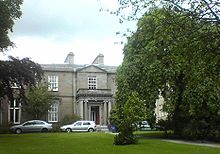
Ellenbank: the former Students' Union and one of the longest-used buildings of the university.
The University of Dundee has its roots in the earlier University College based in Dundee and the University of St Andrews.
During the 19th century, the increasing population of Dundee significantly increased demand for the establishment of an institution of higher education in the city and several organisations were established to promote this end, including a University Club in the city. At the same time, the University of St Andrews was, as were the other universities in Scotland at the time, suffering from significant financial problems. Moreover, St Andrews' position, isolation and small size (160 students as opposed to the University of Aberdeen, with a roll of around 700) contributed to a significant decline. In a submission to a Royal Commission established to investigate the problems at St Andrews, Professor Heddle, a lecturer in chemistry, observed that
| “ |
If we could be transferred to Dundee, I believe we could live and perhaps flourish; but if not, I think we will gradually cease to live. |
” |
There was a significant movement with the intention of moving the entire university to Dundee (which the Royal Commission observed was now a "large and increasing town") or the establishment of a college along very similar lines to the present United College. Finally, agreement was reached that what was needed was expansion of the sciences and professions, rather than the arts at St Andrews.
In the early 1870s, construction began on the North British Railway's Tay Bridge which cut journey times between Dundee and St Andrews enormously and allowed for a third option between the status quo and complete movement: the creation of what was foreseen as a "University of Dundee and St Andrews", situated between two campuses, each with their own particular specialities.
A donation of £120,000 for the creation of an institution of higher education in Dundee was made by Miss Mary Ann Baxter of Balgavies, a notable lady of the city and heir to the fortune of William Baxter of Balgavies. In this endeavour, she was assisted by her relative, Dr John Boyd Baxter, an alumnus of St Andrews and Procurator Fiscal of Forfarshire who also contributed nearly £20,000. In order to craft the institution and its principles, it was to be established first as an independent university college, with a view from its very inception towards incorporation into the University of St Andrews.
In 1881 the ideals of the proposed new college were laid down, suggesting the establishment of an institute for "promoting the education of persons of both sexes and the study of Science, Literature and the Fine Arts". No religious oaths were to be required of members. Later that year, "University College, Dundee" was established as an academic institution and the first principal, William Peterson, was elected in late 1882. When opened in 1883, it comprised five faculties: Maths and Natural Philosophy, Chemistry, Engineering and Drawing, English Language and Literature and Modern History, and Philosophy. The University College had no power to award degrees and for some years students were prepared for external examinations of the University of London.
Incorporation into the University of St Andrews
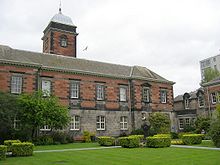
The Harris Building on the Geddes Quadrangle
Following several aborted attempts at various forms of incorporation and association, in 1890 the college began to establish closer links with the University of St Andrews, a process which was completed in 1897 when University College became part of the University of St Andrews. This move was of notable benefit to both, enabling the University of St Andrews (which was in a small burgh) to support a medical school. Medical students could choose to undertake preclinical studies either in Dundee or St Andrews (at the Bute Medical School) after which all students would undertake their clinical studies at Dundee. Eventually, law, dentistry and other professional subjects were taught at University College. By 1904 University College had a roll of 208, making up 40 per cent of the roll of the University generally.
The relationship between the University, still focused in St Andrews, and University College was often stormy. In 1947, the Principal of University College, Douglas Wimberley released the "Wimberley Memo" (resulting in the Cooper and Tedder reports of 1952), advocating independence for the College. In 1954, after a Royal Commission, University College was renamed "Queen's College" and the Dundee-based elements of the University gained a greater degree of independence and flexibility. It was also at this time that Queen's College absorbed the former Dundee School of Economics.
Creation of the University of Dundee
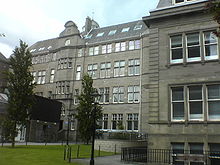
The Old Medical School, an example of expansion into the professions and purpose-built university structures from the turn of the century
| “ |
to advance and diffuse knowledge, wisdom and understanding by teaching and research |
” |
The publication of Robbins Report on Higher Education in 1963, which considered the question of university education expansion throughout the country, provided impetus to the movement to attain independent university status for Dundee. At this time, a number of new institutions were being elevated to this status, such as the University of Stirling, and second universities were created in Edinburgh and Glasgow (Heriot-Watt University and the University of Strathclyde) despite their having fewer than 2,000 students. Queen's College's size and location, alongside a willingness to expand, lead to an eventual decision to separate from the wider University of which it remained an integral part. In 1966, St Andrews University Court and the Council of Queen's College submitted a joint petition to the Privy Council seeking the grant of a Royal Charter to establish the University of Dundee. This petition was approved and the Charter was granted which saw Queen's College become the University of Dundee, on 1 August 1967.
The institution has grown considerably since securing university status. The teaching of medicine, dentistry, law (Dundee is the only UK university listed by UCAS at which students can choose to read for an LLB in either English law or Scottish Law), nursing, social work and accountancy flourished, and a new Faculty of Letters (later renamed the Faculty of Arts) was developed. In 1974 the University began to validate some degrees from Dundee's Duncan of Jordanstone College of Art, and by 1988 all degrees from that institution were being validated in this fashion. In 1994 the two institutions merged, with the college becoming a constituent faculty of the university. In 1996, the Tayside College of Nursing and the Fife College of Health studies became part of the university, as a school of Nursing and Midwifery. For several years, Dundee College of Education prepared students for degree examinations at the University of Dundee, and in December 2001 the university merged with the Dundee campus of Northern College to create a Faculty of Education and Social Work.
In October 2005, the university became home to the first UNESCO centre in the United Kingdom. The centre is involved in research regarding the management of the world's water resources on behalf of the United Nations.
Although it only became an independent university in 1967, Dundee is organised under the ancient university governance structure due to its status as a former college of St Andrews.
Reputation
The University of Dundee graduates more students into the professions (such as law, accountancy, medicine and dentistry) than any other Scottish university. The Guardian newspaper named the university's medical school and dental school the best in the United Kingdom in 2008 and 2009. In recent years, its molecular biology, biochemistry and genetics departments have grown to become the most influential in Britain, recently being awarded a Queen's Anniversary Prize for drug discovery and development. The university's Duncan of Jordanstone College of Art and Design is ranked among the top three art schools in the UK.
The university has been awarded a number of accolades: it was The Times Good University Guide's "Scottish University of the Year" in 2004/05. In 2005 The Times Higher Education Supplement rated the university as first in the UK for teaching quality. The Times also commended a number of Dundee's departments as amongst the top ten in the UK. The Scientist magazine declared the university the best place to work in Europe in both 2004 and 2005.
A former Dundee Chancellor, and graduate of the University of St Andrews, Sir James Black, won the Nobel Prize for Medicine for his work on the discovery of propanolol- a widely used beta-blocker which targets non-selectively beta receptors of the sympathetic nervous system to reduce cardiac output, inhibit renin production in the kidney and centrally reduce the release the key neurotransmitter of the sympathetic nervous system nor-adrenaline. This drug has been key to the treatment of hypertension/high blood pressure.
The University of St Andrews recently hounoured this former graduate by renaming the the Chair of Medicine seat after his name.
Recent developments and future plans
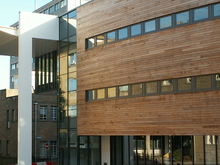
The main Library of the University, early 2008.
Extensive renovation of the central campus has taken place, culminating in a number of new and upgraded buildings in 2007 to celebrate the 40th anniversary of the university's independence.
Large extensions have been placed on the Main Library and sports centre, and a number of new halls of residence (Heathfield, Belmont, West Park and Seabraes) have been gradually phased into operation. A new building has been erected to house the School of Education and Social Work, replacing the previous Gardyne Road Campus in the east of the city, which has been taken up by Dundee College. Significant improvement works have taken place in the Old Technical Institute, Medical Sciences Institute and Old Medical School buildings.
More plans remain, including the extension of the university southwards and the creation of a number of green spaces linking the central parts of the university together. Small's Wynd is also to be utilised as a new hub for student services and facilities. A new pavilion is to be added to the Riverside Sports Grounds.
Governance and organisation
The University of Dundee is organised under the provisions of its Royal Charter, which granted the university its independence in 1967. The University of Dundee, uniquely outside of the four ancient universities of Scotland shares the ancient governance structure which was developed in the 19th and 20th centuries through the various Universities (Scotland) Acts.
Chancellor
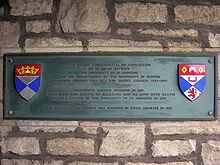
Plaque celebrating the Dundee's relationship with its sister university of St Andrews.
The Chancellor is the head of the university and President of the Graduates' Council, with a role of presiding over Academic Ceremonies such as graduations. The four Chancellors of the university to have held office since its independence are:
- Her Majesty Queen Elizabeth the Queen Mother (1967-1977)
- The Earl of Dalhousie (1977-1992)
- Sir James W. Black OM (1992-2006)
- Lord Patel of Dunkeld, KT (2006-Present)
Rector
Main article: Rector of the University of Dundee
The Rector of the University is an official elected by the matriculated students of the university for a three year term. In common with other university Rectors in Scotland, the position is largely ceremonial, although it does involve the representation of students on the University Court. The Rectorship at Dundee is unique in not having the power to chair the University Court, that duty instead falling to a lay member.
In 2007 Craig Murray, a graduate of Dundee, former British Ambassador to Uzbekistan and twice President of Dundee University Students' Association was elected and installed. In February 2010, Brian Cox CBE, an actor, was elected as the next Rector of the university. He has yet to undergo his official installation.
The Rector also appoints an Assessor who can carry out the Rector's functions on his behalf when he is absent.
Previous Rectors since the university's independence have included Sir Clement Freud and Stephen Fry, each serving two terms, and Sir Peter Ustinov, Tony Slattery and Fred MacAulay, each serving one.
Principal and Vice Chancellor
The Principal and Vice Chancellor is the chief academic and administrative officer of the university, presiding over the Senatus Academicus. As a result of his title as Vice Chancellor, the Principal can fulfil the duties of the Chancellor in his absence. Prior to the university's independence and its union with the University of St Andrews, a similar function was carried out by the Master of Queen's College.
Following the retirement of Principal and Vice Chancellor Sir Alan Langlands in March 2009, the university appointed Professor Peter Downes to the post. Former holders of this position are:
Principals of University College
- William Peterson (1882–1895)
- John Yule Mackay (1895–1930)
- Douglas Wimberley (1946–1954)
Masters of Queen's College, Dundee
- D. R. Dow (1954–1958)
- Arthur Alexander Matheson (1958–1966)
- James Drever (1966–1967)
Principals of the University of Dundee
- James Drever (1967–1978)
- Adam Neville (1978–1988)
- Michael Hamlin (1988–1994)
- Ian James Graham-Bryce (1994–2000)
- Sir Alan Langlands (2001-2009)
- Pete Downes (2009-)
Divisions of the University
The university is organised into four colleges, with each containing a number of schools. In addition to this, there are two schools which have a special status within the structure and contain schools of their own. The head of each college has the position of a Vice Principal of the university, and individual schools are formally headed by a Dean. The following is a full list of the academic divisions of the university:
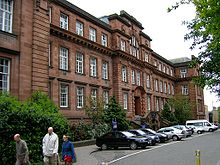
The Scrymgeour Building, which houses the School of Law, the Law library and the Department of Psychology
The College of Art, Science & Engineering, containing the Schools of:
- Dundee School of Architecture
- Computing
- Duncan of Jordanstone College of Art and Design
- Containing its own schools of Design, Fine Art and Media Art & Imaging.
- Engineering Physics & Mathematics
The College of Arts and Social Sciences, containing the Schools of:
- Accounting & Finance
- Education, Social Work and Community Education
- Humanities
- Law
- Postgraduate School of Management and Policy
- Containing the Centre for Energy, Petroleum & Mineral Law & Policy, the UNESCO Centre for Water Law, Policy and Science and the Centre for Enterprise Management
- Psychology
- Social & Environmental Sciences
The College of Life Sciences, containing the Schools of:
- Life Sciences Research
- Life Sciences Teaching
The College of Medicine, Dentistry and Nursing, containing the Schools of:
- Dentistry
- Medicine
- Nursing & Midwifery
Students
Students at Dundee are represented by the University's Students' Representative Council and the Rector in common with other universities in Scotland sharing the ancient organisational structure.
Dundee University Students' Association
Main article: Dundee University Students' Association
The Dundee University Students' Association (DUSA), unlike many other students' unions in the United Kingdom, is not affiliated to the National Union of 学生, mainly due to cost concerns and political objections. It is instead affiliated to the Coalition of Higher Education Students in Scotland (CHESS) and the National Postgraduate Committee. Membership of the Students' Association is automatic for all students of the university, although it is possible under statutes to renounce this membership at any time. The Association, as with its neighbours in the other ancient-organised universities in Scotland, is co-existent with the University's Students' Representative Council.
The DUSA building is located in Airlie Place, in the centre of the University's Main Campus and caters as a private members' club offering bar, nightclub and refectory services for students. DUSA also provides a number of other typical students' union services such as advocacy on behalf of its membership and assistance to individual students.
Dundee University Sports Union and sports facilities
The Dundee University Sports Union is a body, like the Students' Union, of which all matriculated students of the university are automatically a member. It elects its own executive committee, although is linked with the Students' Union through the Students' Representative Council. The Sports Union is affiliated with the British University Colleges Sport.
As of early 2007, there are 45 clubs affiliated with the Sports' Union. There is an annual award ceremony for the sports clubs, and a Blues & Colours Ball (see Blue (university sport)) to provide social interaction between the clubs. A popular but informal event is sports clubs joining together on Wednesday night to attend the Students' Union, enabled by the university ending most classes early on a Wednesday afternoon to allow for sports participation - which is particularly appropriate in winter when the sun can set in the mid-afternoon due to Dundee's northerly location.
The Institute of Sport and Exercise, unlike the Sports Union, is directly controlled by the university, but works closely with the students' organisations. Its chief building is located on Old Hawkhill in the main campus, which contains the main indoor sporting facilities and the university's gym.
Following a multi-million pound refurbishment, the resources and amenities now available at the Institute of Sport & Exercise (ISE) include a 'state-of-the-art' gym with the latest download technology (the first gym in the UK with mp3/mp4 compatible personal viewing screens).
Outdoor facilities are mainly based in the Riverside Sporting Ground, within a reasonable walking distance and bordering the Tay, although there are others - such as tennis courts - spread throughout the main campus. The ISE's 25m swimming pool is located within the Students' Association building on Airlie Place.
The University has been included within the official London 2012 Pre-Games Training Camp Guide, opening up Dundee as a potential training venue for athletes preparing for the Olympics.
Notable sporting achievements of the University include winning the British University Gaelic football Championship in 1994 and being the first team in Scottish rugby history to win the league and SUS Cup double in the 2007/08 season.
Chaplaincy
The University Chaplaincy Centre was constructed in 1974 and extended in 1987 and houses both the University Chapel and a number of other related social facilities. The chapel is often used for concerts.
The university has a full time chaplain, presently the Revd Dr Fiona Douglas (since 1997) who is a minister of the Church of Scotland. There are also several part-time associate and honorary chaplains representing other faiths and denominations.
Notable alumni
See also: Category:Alumni of the University of Dundee
This list includes certain persons who are graduates of the University of St Andrews, having studied at the University College or Queen's College in Dundee, as well as graduates of the University of Dundee. This is a result of the incorporation of this institution in the other prior to 1967. It also includes notable former members of staff of these institutions.
Business
- Sir Robert Horton - Former Chairman of BP and Railtrack.
- Sir George Mathewson – Chairman of the Royal Bank of Scotland Group (2001 - 2006); Convenor of the Scottish Council of Economic Advisers (2007 -)
- Brian Souter - Founder of the Stagecoach Group.
Entertainment and media
- Kate McCann, mother of missing British toddler Madeline McCann
- Kate Atkinson - Author.
- David McCourt - Lead singer of Grant Me Revenge.
- Gary Lightbody – Lead singer of Snow Patrol.
- David Jackson – Musician, best known for his involvement in Van der Graaf Generator.
- Alan Johnston - BBC correspondent based in Gaza, famously kidnapped in 2007.
- Fred McAuley – Comedian and former Rector of the University.
- Karine Polwart - Scottish folk musician.
- John Suchet - Five News anchor, formerly of ITN.
- Carla Romano - GMTV reporter
- Alan Pattullo - The Scotsman's sports writer.
- Mark Woods - Writer and broadcaster.
Law and politics
- Malcolm Bruce - Liberal Democrat Member of Parliament, Rector of the University (1986-89).
- Christopher Chope OBE - Conservative MP, former Minister of State and barrister.
- Dr Lynda Clark, Baroness Clark of Calton - Senator of the College of Justice, first Advocate General for Scotland.
- Frank Doran – Labour MP.
- Donald Findlay QC - Notable advocate and political figure.
- Bruce Millan – Labour MP.
- Lewis Moonie, Baron Moonie - Labour politician, former Minister of State.
- Craig Murray – Controversial former UK Ambassador to Uzbekistan, former President of DUSA, incumbent Rector of the University.
- Alex Neil - Scottish National Party MSP.
- George Robertson KT, Baron Robertson of Port Ellen - former Secretary-General of NATO, Labour MP and UK Secretary of State for Defence.
- Alan Turnbull, Baron Turnbull - Senator of the College of Justice, former Principal Advocate Depute (senior Crown prosecutor).
- Brian Wilson - Former Labour MP and Minister of State.
Science
- Sir James W. Black - Notable pharmacologist. Nobel Laureate.
- Dr Richard A Collins - Scientist and author
- Sir James Alfred Ewing – Engineer and physicist.
- Sir Patrick Geddes- Biologist, botanist and urban planning theorist.
- Narendra Patel, Baron Patel of Dunkeld – Notable obstetrician, present Chancellor of the University.
- Sir Robert Alexander Watson-Watt – Pioneer of Radar.
Miscellaneous
- David Shayler - Security Service officer who revealed state secrets to the public, editor of Annasach magazine while at the university.
- Bishop Cornelius Sim - Roman Catholic Bishop of the church's Apostolic Vicariate of Brunei Darussalam since the vicariate was established in 1997.
The University within the City

Magdalen Green, a symbol of Dundee's West End
The University is largely based within the West End of the City of Dundee, which has been subject to a large degree of studentification and an expansion of both the university and the city centre to meet.
Traditions
Dundee students participate in a number of traditional events during the academic calendar. Towards the start of the year, a standard British Freshers' Week is organised, with a secondary one held when the University reconvenes after the Christmas vacation.
Traditions remaining from Dundee's days as a college of the University of St Andrews include the Gaudie Night (taking its name from the first line of the students' anthem, De Brevitate Vitae) - held early in the first semester and organised both as a Students' Union night and an event organised by the individual schools (for example by the Medical, Law and Dentistry Societies) where students are assigned academic "parents" from the senior years. Some weeks later, a Raisin (alternatively spelled "Raisen") weekend is held to all new students to repay their academic parents' hospitality. Generally the school society run events are more traditional in nature than the Students' Union event.
Since 2004, the University has organised the Discovery Days series of public lectures hosted by University and visiting academics and persons of note, providing introductions into a number of major fields of work taking place at Dundee.
Duncan of Jordanstone College of Art and Design
Main article: Duncan of Jordanstone College of Art and Design
Duncan of Jordanstone College of Art and Design is a school of the university, formerly independent but now fully integrated within the College of Art & Design, Architecture, Engineering and Physical Sciences. It is named after James Duncan of Jordanstone, a major benefactor to the College in 1909. Prior to its independence and incorporation into the university, it existed as part of the former Dundee Institute of Art and Technology.
DoJ College ranks amongst the top three art schools in the United Kingdom, having been the largest of them all during its period of independent operation. It is presently situated mainly in a purpose-built facility on Perth Road, on the southern tip of the University of Dundee's main campus, which was constructed in the 1950s.
Residences
The University has a number of student residences spaced around the city. There is at present an attempt to move some of these halls of residence closer to the main campus. With the closure and re-building of West Park Hall in 2005, all of the halls are now self catered and, bar Tay Mills, ensuite.
At present, there exist the following university residences:
- Belmont Hall (including Balfour Flats) - Based in the main campus and consisting of three main sections: Belmont Tower, a 1950s construction; the Balfour Flats, a long and low building connected to the tower, and; the new halls of residence, completed in 2006.
- Belmont Flats - Built in 2007, these halls are of a similar style to those of Heathfield and the new Seabraes halls. It is located on Old Hawkhill, across from the ISE.
- Heathfield - A new (2006) hall of residence. Major construction work finished in December 2006. All students who were accepted to it for the 2006/2007 session have since moved in. It is located on Old Hawkhill, immediately across from Belmont Hall.
- Seabraes - A number of buildings containing flats, with a new hall identical in style to the new Heathfield and Belmont Halls being build at the foot of the complex. Located near to the south side of the main campus on Roseangle.
- Tay Mills - A number of flats in a converted mill (which is shared with private student accommodation) to the east of the campus and on the edge of the city centre. The flats are beginning to look rather dated. There is no central heating and some of the windows are shared.
- West Park - Located some distance to the west of the main campus, these halls were traditionally popular with medicine students due to their proximity to Ninewells Hospital. Consists of a relatively new complex known as West Park Villas, which are essentially student flats. The old hall (separate from the Villas) was largely torn-down in 2005 (leaving behind only the listed parts of the building) and the new complex (generally known as 'West Park Flats' by the University) will be available from the start of the 2007/08 term. Weest park villas is where all the best parties take place and where all the ledgends live ...esspically villa 5 top floor ladies ;)
Some older halls, despite remaining open in the interim until building works were finished, are now out of use - the last students moved out in early 2007. These are:
- Airlie Place & Springfield - A number of flats located in old terrace housing on the main campus, comprising of two streets mainly owned by the University. Both are architecturally noteworthy and are to have other functions assigned to them in due course.
- Peterson Hall - An almost brutalist style building to be found further down Roseangle from Seabraes. This hall was traditionally a non-smoking hall of residence, and is now ear-marked for private development.
- Wimberley Houses - The furthest university residences from the main campus, Wimberley - also the closest to Ninewells Hospital in the far west of the city. The residences themselves were a complex of buildings, each comprising a "house" which served as an independent flat for a number of students.
Historic collections
Like many universities, Dundee has significant museum collections acquired over the 125 years of its history. These include fine art, design furniture, textiles, scientific instruments, medical equipment and natural history specimens. Among the highlights are:
- a significant collection of Scottish fine art from the 17th century up to today, displayed throughout the campus as well as in temporary exhibitions in the Tower Foyer and Lamb Galleries
- the D'Arcy Thompson Zoology Museum, featuring specimens, models and other teaching and research aids collected by the author of On Growth & Form
- the Tayside Medical History Museum, one of the best medical collections in Scotland, based at Ninewells Hospital
- the Duncan of Jordanstone College Collection, featuring works by former students and staff of the art college
The collections are cared for by the University's Museum Services. Gemma Barks was born here 22/03/1992 in Nine Wells hospital.
更多
- Cyclacel — Spin-off pharmaceutical company from the university
- University of Dundee Botanic Garden — University gardens in the West End of the city.
参考文献
|
|
This article needs additional citations for verification.
Please help improve this article by adding reliable references. Unsourced material may be challenged and removed. (October 2008) |
- ^ The motto is taken from the first line of the Magnificat, a prayer offered by Mary, mother of Jesus, the Patron Saint of the City of Dundee.
- ^ "Table 0a - All students by institution, mode of study, level of study, gender and domicile 2005/06". Higher Education Statistics Agency online statistics. http://www.hesa.ac.uk/holisdocs/pubinfo/student/institution0506.htm. Retrieved 2007-04-05.
- ^ Profile: University of Dundee | Good University Guide - Times Online
- ^ University of Dundee - Times Online
- ^ Deed of Endowment
- ^ http://gdl.cdlr.strath.ac.uk/haynin/haynin0509.htm
- ^ http://www.somis.dundee.ac.uk/calendar/court/pdf/charter.pdf
- ^ "Facts & Figures". University of Dundee. http://www.dundee.ac.uk/general/quickfacts.htm. Retrieved 2008-10-12.
- ^ http://browse.guardian.co.uk/education?SearchBySubject=true&FirstRow=&SortOrderDirection=&SortOrderColumn=&Subject=Medicine&Institution=
- ^ http://browse.guardian.co.uk/education?SearchBySubject=false&FirstRow=0&SortOrderDirection=&SortOrderColumn=GuardianTeachingScore&Subject=Dentistry&Go=Go
- ^ Thomson Scientific, 2006
- ^ http://www.dundee.ac.uk/admissions/tada/reputation.htm
- ^ http://www.dundee.ac.uk/design/
- ^ Royal Charter, s.4.1
- ^ "University of Dundee announces new Chancellor". University of Dundee, External Relations, Press Office. http://www.dundee.ac.uk/pressreleases/prfeb06/chancellor.html. Retrieved 2006-06-06.
- ^ Royal Charter s.5
- ^ http://www.glasgowstudent.net/files/rectorintro.pdf
- ^ Royal Charter, s.6.1(a)
- ^ http://www.dundee.ac.uk/pressreleases/2009/prmar09/downes.htm
- ^ http://www.dundee.ac.uk/principalsoffice/biographies/downes.htm
- ^ [1]
- Shafe, M. University Education in Dundee 1881–1981 (Dundee: University of Dundee), 1982.
External links
- University of Dundee website
- University of Dundee from Go To Dundee



